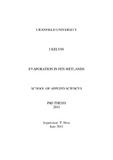JavaScript is disabled for your browser. Some features of this site may not work without it.
| dc.contributor.advisor | Hess, Tim M. | |
| dc.contributor.author | Kelvin, J. | |
| dc.date.accessioned | 2012-05-21T09:12:53Z | |
| dc.date.available | 2012-05-21T09:12:53Z | |
| dc.date.issued | 2011-06 | |
| dc.identifier.uri | http://dspace.lib.cranfield.ac.uk/handle/1826/7166 | |
| dc.description.abstract | Wicken Fen represents a remnant of the once extensive peat fenlands of East Anglia, which survived large-scale drainage efforts intended to bring land into agricultural production due to its importance within the local economy and subsequently as a site of interest to scientists. Wicken Fen is managed so as to conserve a variety of habitats lost as a result of drainage and therefore does not represent a truly natural environment. Traditional management practices on Sedge Fen, the largest part of Wicken Fen, involve maintaining a 3 – 4 year harvesting cycle and controlling soil water levels. Previous hydrological studies of Wicken Fen have determined that soil water levels are strongly influenced by precipitation and evapotranspiration. The evaporative flux at Sedge Fen is commonly estimated by using meteorological data within empirical formulae such as the Penman Monteith equation owing to measurement difficulties. Furthermore, there has been little investigation of the evaporative loss from fens within the UK. This study aims to investigate the evaporative loss from Sedge Fen so as to better inform hydrological management and to describe evapotranspiration estimation techniques which may be employed at other fen sites. Eddy covariance measurements demonstrated that evapotranspiration from Sedge Fen was typically less than reference evapotranspiration estimates. Evapotranspiration estimates may be improved by consideration of surface parameters which can be described using meteorological data. Meteorological differences existed between Sedge Fen and the surrounding area, resulting in differing evapotranspiration estimates depending on where data was collected. Evapotranspiration measurements were used within a simple water budget model of Sedge Fen and demonstrated the lateral movement of soil water, a hydrological flux previously assumed to be of little consequence within the hydrological balance of Sedge Fen. | en_UK |
| dc.language.iso | en | en_UK |
| dc.publisher | Cranfield University | en_UK |
| dc.rights | © Cranfield University 2011. All rights reserved. No part of this publication may be reproduced without the written permission of the copyright owner. | en_UK |
| dc.title | Evaporation in fen wetlands | en_UK |
| dc.type | Thesis or dissertation | en_UK |
| dc.type.qualificationlevel | Doctoral | en_UK |
| dc.type.qualificationname | PhD | en_UK |
